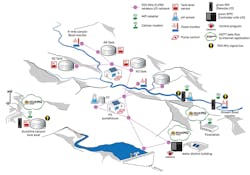The fast-evolving Industrial Internet of Things (IIoT) landscape requires potential users to be even more open-minded in learning what IIoT can do and more flexible in keeping up with its advances as they leap ahead. For instance, Pine Brook Water District in rural Boulder, Colo., traditionally managed its natural water supply with manual rounds to monitor tanks and stream levels, and verify pump station operations. However, it experienced a couple of water tank overflows in recent years, so it decided to migrate to an automated system. The district also needed to track where its water was going, so it could detect leaks. Plus, since there’s a risk of flooding from its stream, it wanted to create a high-level alert system to protect residents.
To automate its monitoring tasks, Pine Brook enlisted distributor Rust Automation & Controls (A&C) Inc. in West Jordan, Utah, which performed an initial site survey. The district’s 500-acre site doesn’t have many assets, but they’re widely distributed, and don’t have any power or communications. Rust also identified three isolated sites critical for flood monitoring, but they were in hilly terrain that would block radio signals, while adding towers would be too costly (Figure 1).
Figure 1: Pine Brook water district in Boulder, Colo., recently worked with Rust Automation & Controls to automate its water monitoring and flood alert system by implementing solar-powered monitoring stations, including 4-20 mA radar level gauges and relays for controlling pumps and valves, which are linked by an Elpro 900 MHz, wireless I/O mesh transceiver network. At three isolated sites, it connected to the Internet instead via Wi-Fi adapters at two stations linked to a nearby fire station and via a 4G cellular modem at the third station, and used native MQTT support in Opto 22’s groov RIO MM1 modules and HiveMQ’s cloud-native MQTT broker to transport I/O data securely via the Internet. Source: Pine Brook Water District and Opto 22
Consequently, Rust implemented solar-powered monitors across the district, most linked by an Elpro 900 MHz wireless I/O mesh transceiver network. These stations included 4-20 mA radar level gauges and relays for controlling pumps and valves. At the three isolated locations, the distributor decided to connect to the Internet, rather than join the mesh network. At two sites, it substituted Wi-Fi adapters for the transceivers, and linked to a wireless network at a nearby fire station. In the third spot, Rust installed a 4G/LTE cell modem. To relay Pine Brook’s sensor data easily via the Internet, it decided to try I/O at the edge strategy, and installed Opto 22’s compact groov RIO MM1 modules with eight channels of universal I/O, two mechanical relays, embedded Ethernet, data storage, software apps and data services.
The Industrial Internet of Things is surpassing itself with added data sources, more detailed information and greater insights—if users are open-minded and flexible enough to try it. Read more of this series here.
The modules established Wi-Fi and cellular links, and configured I/O and Modbus TCP connections to integrate data from the utility’s local devices and transceiver network extensions. Each edge I/O module was secured with user authentication and SSL/TLS certificates, using native certificate management built into groov RIO’s management layer. Using the Codesys control engine on the network’s primary groov EPIC controller, Rust’s team configured each station as a remote I/O point, wrote polling logic, and defined alarm limits. Codesys is the team’s preferred control platform because it lets them use all IEC languages where they’re most appropriate. They usually use structured text (ST) for math and time calculations, function block (FB) for the main program routine, and ladder (LD) when orchestrating an action sequence.
Brokered by MQTT
However, when Rust tried to connect to the groov RIO modules via Codesys, it encountered too much latency to maintain the link. Plus, there were some security concerns because talking to two of the modules required opening ports in the fire station’s firewall. Consequently, Jared Bates, project team leader at Rust, reports they decided to flip their approach. Instead of scanning the remote I/O at high resolution from the main controller, they connected these three sites to an MQTT broker using the modules’ native MQTT publishing capabilities. They picked HiveMQ’s cloud-native MQTT broker, which allows 100 MQTT clients to communicate for free, keeping maintenance costs low.
MQTT clients publish data only when changes occur, so Pinebrook wouldn’t need a high-speed, always-on connection to get accurate data. And, because MQTT links always originate from the edge device, Rust wouldn’t have to open firewall ports to allow inbound connection requests to the district’s groov RIO modules. Bates reports that integrating MQTT data into the main control program was simple using MQTT’s client library for Codesys. These MQTT functions let the groov EPIC controller subscribe to all the data in the MQTT broker, and integrate it directly into the control program like native tags.
“Reliability was more important than performance,” says Bates. “Updates even every 10 minutes would have been acceptable in this case. This gave us some wiggle room to slow down scan rates, so we hit the broker probably only once a minute.”
Embedded HMI, extra I/O
To accommodate Pinebrook’s budget, Rust also decided not to install a full SCADA system. Instead, the team built all the control, communication and even visualization into the edge controller. Since the utility was manually managed before this project, it also needed a visual interface for its new control network. To hold down costs and simplify long-term maintenance, Rust also decided to use the controller’s groov View embedded HMI server. It lets designers use a web-based editor with drag-and-drop components to build HTML5-compliant displays that run on groov EPIC’s touchscreen, external displays, connected mobile and desktop browsers, or on the groov View app. In addition, groov View is included free with groov EPIC, so it also didn’t add to Pine Brook’s expenses. Also, because groov EPIC runs Node-RED IoT programming environment, Rust used it to format some of the data it pulled from Codesys, so it could display properly in the HMI.
“groov View uses OPC UA, so we could connect Codesys and groov View pretty seamlessly, and just drag and drop many of the controls on it,” adds Bates.
Because the district’s central edge controller was located at the water treatment plant, Rust added extra I/O modules to connect to some of its other equipment. The main HMI page displays field measurements such as storage tank levels next to raw water measurements from the plant’s inlet. The middle of the display shows analytical measurements of trace compounds like chlorine and manganese along with weekly river level changes—which act as Pine Brook’s flood alert system. When it alarms, groov View texts Pine Brook personnel, who can access the HMI via web browsers on personal workstations and on a 42-inch touchscreen in the main control room that’s connected to groov EPIC’s HDMI port.
Bates reports Pine Brook’s staff is happy with their new wireless, cellular, Internet-based water monitoring system, which incurs only minimal monthly costs for maintaining one cell modem and some management of the MQTT broker. They can monitor tanks and pumps to make sure they aren’t overflowing, initiate control tasks, or adjust the HMI as needed. With the exception of the HiveMQ broker, all its functions—control engine, HMI server, Node-RED, MQTT publish-subscribe communication and device security—run the groov devices and don’t require a Windows PC or external server for data or communication.
“We made it our best practice to use a groov EPIC as an edge device for connectivity, even if we’re using a different PLC,” adds Bates. “It solves many issues because it has many built-in software solutions.”







